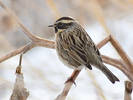search
classification
|
basic information
|
video
|
reports |
Black-throated Accentor
Prunella atrogularis (Brandt, 1844)

|
 adult, spring
|
|
|
2015-04-17
Chunkurchak gorge, Kyrgyz ridge, Chuy region |
© Sergey Toropov
|
|
Description
The adult Black-throated Accentor in breeding plumage has brownish-black crown sometimes with buffy-grey edges of feathers. The neck and mantle are buffy-brownish with black-brown neat streaks, the rump and uppertail are grayish-brown. The bright almost white supercilium extends from the bill to nape. Lores, ear covers, chin and throat are brown-black, the craw and breast are buffy, other underparts are off-white with dark-brown streaks on flanks. The flight feathers and its coverts are dark-brown with buffy-brownish edges, especially on greater coverts. The tail feathers are dark-brown. Legs are yellow, eyes are brown. In fresh autumn plumage the buffy-brownish edges on the upperparts and wings feathers are much expanded. Moreover more pale tips of greater coverts form the narrow wing-bar. Supercilium, craw and breast are bright buffy, the same color edges sometimes fully hide the black throat and chin. Juvenile bird is buffy-brownish above with neat black-brown streaks on mantle and faint streaks on crown. Supercilium and underparts are off-white with dark-brown streaks lacking on the median-belly and undertail. Sizes: length 150-170; males – wing 68-77; females – wing 68-73 mm; weight: 14,5 – 23,6 grams.
Biology
The Black-throated Accentor is a common resident and/or passage migrant. Inhabits coniferous forest (spruce, larch, spruce/fir) with shrubby clearings; mixed forest with birch and asp, and light juniper/spruce forest at 1400-2800 m in Tien Shan, and 1400-2000 m in Altai. On passage occurs in gardens, forest-belt, riparian forest, tall weeds and rarely in reed beds. In spring, movements in southern areas observed between mid February and mid April. In Altai appears late in March to mid of April, last migrants recorded in mid May. Breeds in separate pairs 40-200 m each from another. Nest is built in trees (spruce, larch) or bushes (juniper, honeysuckle, willow, dog-rose, cornel-bush) 0.4-15 m, often 1-2 m off the ground, and is made of thin twigs, dry grass and moss lined with hair and sometimes with vegetation fluff and some feathers. Only female builds the nest over 7-18 days. Clutches of 3-6 eggs found early May – late July. Female incubates for 11-14 days, male only rarely feeding her. Both parents feed juveniles, who fledge at 11-14 days, from mid June to mid August. Double, sometimes triple brooded, repeated breeding after nest loss is common. Autumn passage begins late in September to early October. At Chokpak Pass singles of nominate subspecies were caught repeatedly 14-30 October in 1968, 1970, 1976, 1990, 1994-1995, 2003-2004.
References
"Птицы Казахстана" том 3. "Наука". Алма-Ата, 1970. Gavrilov E. I., Gavrilov A. E. "The Birds of Kazakhstan". Almaty, 2005. Э.И.Гаврилов. "Фауна и распространение птиц Казахстана". Алматы, 1999. Г.П. Дементьев "Птицы СССР" том IV, 1937.












